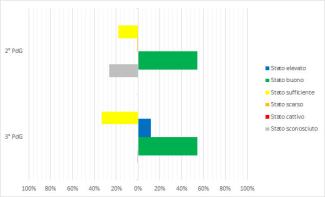Panel 1
Marina Penna
Coastal marine waters are defined as “surface waters situated inside an imaginary line one nautical mile away, at every point, on the outer side from the nearest point of the baseline used to define the territorial sea limit, and potentially extending to the outer boundary of transitional waters.” The legislation (Legislative Decree 152/2006) mandates achieving "good" status (ecological + chemical) for water bodies by the deadlines set by current regulations; failure to meet environmental goals entails remediation measures. Based on the analysis of data reported by Districts in the 3rd Reporting to the European Commission for the six-year period 2016–2021 (3rd WMP), the ecological status of Italian coastal marine waters is heterogeneous. This heterogeneity is expressed in both the number of water bodies identified per district and their ecological classification. The Eastern Alps, Northern Apennines, Central Apennines, Sicily, and Sardinia Districts show a percentage of water bodies in good and high ecological status greater than or equal to 70%. Specifically, in the Sardinia District, more than 40% of water bodies are in high status. Nationally, more than 60% of water bodies (261 out of 394 total) are in good and high ecological status. Comparing data from the 2nd WMP and the 3rd WMP shows that in the 2nd WMP, 27% of water bodies had unknown ecological status (149 out of 561 total), while in the 3rd WMP, only one water body is in unknown ecological status. In general terms, the proportion of water bodies in good and high ecological status increased from 55% in the 2nd WMP to 66% in the 3rd WMP.
The definition of ecological status is based on the assessment of the quality status of aquatic flora and benthic macroinvertebrates, supported by the physico-chemical characteristics of the water column and the hydromorphological features of the water body, based on methodologies shared across all hydrographic districts. It is assigned based on the lowest classification values of BQEs (phytoplankton, benthic macroinvertebrates, macroalgae, and angiosperms) selected based on pressure analysis, according to the "one out - all out" principle, then summarized into a judgment based on five quality classes: “high,” “good,” “sufficient,” “poor,” and “bad.”
To verify, every six years, the effectiveness of measures to contain pressures implemented by competent administrations. The ultimate goal of this indicator is to confirm the achievement of "good" status by the dates set by current regulations.
Directive 2000/60/EC Legislative Decree 152/2006 and subsequent amendments. The legislation (Legislative Decree 152/2006) mandates achieving "good" water body status (ecological + chemical) by 2015 or, in the case of an extension, by 2027.
Panel 2
WISE Reporting of the 3rd Water Authority Management Plan of Hydrographic Districts (October 2022 update)
-
-
Data quality assessment
SNPA (National Environment Protection System)
Extracted data Reporting WISE of the 3rd Water Water Management Plan of River Districts (October 2022 update)
National
2010-2015; 2016-2021
Indicator assessment
The ecological status of a water body is defined based on deviations from reference conditions (Ecological Quality Ratio, EQR), determining its placement in one of five classes. Data on Biological Quality Elements (BQEs) per station contribute to the ecological quality assessment for water bodies based on the "one out - all out" principle.
National analysis of coastal marine waters shows that more than 66% of water bodies (291 out of 394 total) are in good and high ecological status, thus approaching the target set by current regulations. The Eastern Alps, Northern Apennines, Central Apennines, Sicily, and Sardinia Districts have a percentage of water bodies in good and high status equal to or greater than 70%. The Sardinia District has the highest percentage of water bodies in high ecological status (44%), while the Po River and Southern Apennines Districts have 67% (2 out of 3 water bodies) and 69% (100 out of 145 water bodies) in sufficient ecological status, respectively (Figure 1).
The time coverage of the indicator does not allow, at the moment, to identify a trend.



Based on the analysis of data reported by Districts in the 3rd Reporting to the European Commission for the six-year period 2016–2021 (updated October 2022), the ecological status of Italian coastal marine waters is heterogeneous. This heterogeneity is expressed in both the number of water bodies identified per district and their ecological classification. Law 221/2015 redefined the boundaries of hydrographic districts; thus, to compare the 2nd and 3rd WMP cycles, water bodies from the 2nd cycle were assigned to districts according to the new boundaries. From this comparison, it emerges that in the 2nd WMP, 27% of water bodies had unknown ecological status (149 out of 561 total), while in the 3rd WMP, only one water body is in unknown status. In general terms, 55% of water bodies were in good and high ecological status in the 2nd WMP, rising to 66% in the 3rd (Figure 3). The 3rd WMP thus shows that, except for one water body, all Italian coastal marine water bodies are monitored, and their ecological status is approaching the quality target set by current regulations. Additionally, with the new boundary calculations, the Sicily District, which had 74% of water bodies in unknown status in the 2nd WMP, presents 75% of water bodies in good ecological status in the 3rd WMP. The Southern Apennines District, which had 57% of water bodies in unknown ecological status in the 2nd WMP, records in the 3rd WMP 1% in high ecological status (2 out of 145 total), 29% in good status (42 water bodies), and 69% in sufficient status (100 water bodies) (Figure 2). This indicator addresses SDG 14 target 14.1, which aims to prevent and significantly reduce marine pollution of all kinds by 2025, particularly from land-based activities.